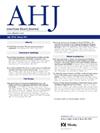Impact of Relacorilant on Blood Pressure and Antihypertensive Medication Burden in Patients With Hypercortisolism and Hypertension: Results From the GRACE Study
IF 3.5
2区 医学
Q1 CARDIAC & CARDIOVASCULAR SYSTEMS
引用次数: 0
Abstract
In the phase 3 GRACE study (NCT03697109) in adults with endogenous hypercortisolism and hypertension, hyperglycemia, or both, relacorilant significantly improved blood pressure (BP), meeting the primary endpoint. We report on the impact of relacorilant on BP and antihypertensive medication use among study participants with hypertension. GRACE comprised a 22-week, open-label (OL) phase of relacorilant 100–400 mg once daily followed by a 12-week, double-blind, placebo-controlled randomized withdrawal phase. Hypertension was defined as mean systolic blood pressure (SBP) 135–170 mm Hg and/or diastolic blood pressure (DBP) 85–110 mm Hg. Among participants with hypertension at OL baseline (n=102), mean SBP and DBP were 141 and 89 mm Hg, respectively, and 76% (78/102) were taking ≥1 antihypertensive medication. The most common (≥15%) antihypertensive classes were calcium channel blockers (31%), angiotensin-converting enzyme (ACE) inhibitors (26%), angiotensin II receptor blockers (ARBs) (25%), beta blockers (22%), and aldosterone antagonists (20%). Relacorilant significantly improved BP from baseline to week 22 (P<0.0001), and 19% (15/78) of those taking antihypertensive medications discontinued and/or decreased use by week 22 or their early termination visit. Medication reductions were most common with aldosterone antagonists (10%) and ARBs (8%). Complete discontinuation was highest for loop diuretics (31%) and calcium channel blockers (19%), followed by aldosterone antagonists (10%), ACE inhibitors (7%), beta blockers (5%), and ARBs (4%). In summary, in GRACE, relacorilant improved BP and resulted in antihypertensive medication decreases/discontinuations for participants with hypertension.
抗凝剂对高皮质醇血症和高血压患者血压和降压药物负担的影响:GRACE研究结果
在3期GRACE研究(NCT03697109)中,患有内源性高皮质醇血症和高血压、高血糖或两者兼有的成人,relacorilant显著改善了血压(BP),达到了主要终点。我们报道了抗凝剂对高血压患者血压和抗高血压药物使用的影响。GRACE包括一个22周的开放标签(OL)期,每日1次,100 - 400mg,然后是一个12周的双盲,安慰剂对照的随机停药期。高血压定义为平均收缩压(SBP) 135-170毫米汞柱和/或舒张压(DBP) 85-110毫米汞柱。在OL基线时患有高血压的参与者中(n=102),平均收缩压和舒张压分别为141和89毫米汞柱,76%(78/102)服用≥1种降压药。最常见(≥15%)的降压药物是钙通道阻滞剂(31%)、血管紧张素转换酶(ACE)抑制剂(26%)、血管紧张素II受体阻滞剂(ARBs)(25%)、受体阻滞剂(22%)和醛固酮拮抗剂(20%)。Relacorilant显著改善了从基线到第22周的血压(P<0.0001), 19%(15/78)服用降压药的患者在第22周或早期终止就诊时停止和/或减少使用降压药。醛固酮拮抗剂(10%)和arb(8%)的减量最为常见。完全停药最多的是利尿剂(31%)和钙通道阻滞剂(19%),其次是醛固酮拮抗剂(10%)、ACE抑制剂(7%)、受体阻滞剂(5%)和arb(4%)。总之,在GRACE试验中,抗凝剂改善了血压,导致高血压患者的降压药减少或停药。
本文章由计算机程序翻译,如有差异,请以英文原文为准。
求助全文
约1分钟内获得全文
求助全文
来源期刊

American heart journal
医学-心血管系统
CiteScore
8.20
自引率
2.10%
发文量
214
审稿时长
38 days
期刊介绍:
The American Heart Journal will consider for publication suitable articles on topics pertaining to the broad discipline of cardiovascular disease. Our goal is to provide the reader primary investigation, scholarly review, and opinion concerning the practice of cardiovascular medicine. We especially encourage submission of 3 types of reports that are not frequently seen in cardiovascular journals: negative clinical studies, reports on study designs, and studies involving the organization of medical care. The Journal does not accept individual case reports or original articles involving bench laboratory or animal research.
 求助内容:
求助内容: 应助结果提醒方式:
应助结果提醒方式:


